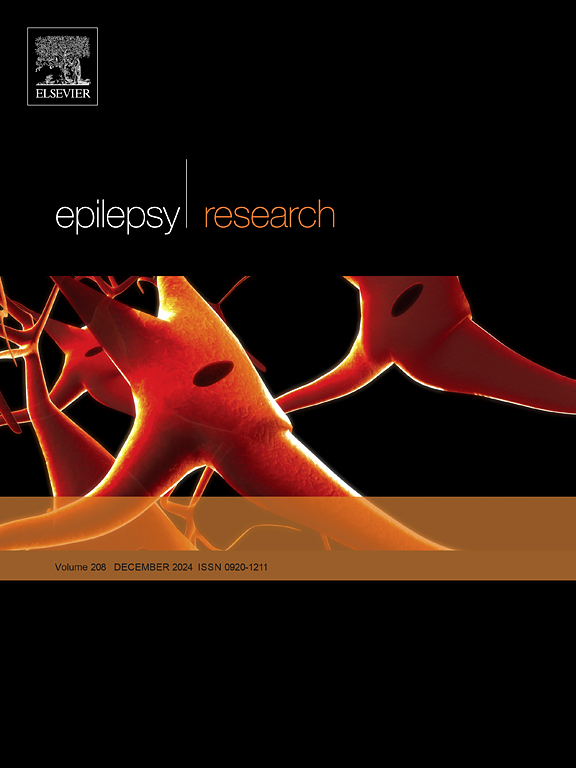Blood-brain barrier impairment as an early marker of neurodegeneration in late-onset epilepsy of unknown origin
IF 2
4区 医学
Q3 CLINICAL NEUROLOGY
引用次数: 0
Abstract
Purpose
Blood-brain barrier (BBB) plays a crucial role in maintaining brain health, and its dysfunction during the early stages of neurodegeneration may contribute to neuropathological processes. Patients with late-onset epilepsy with unknown etiology (LOEU) can present early signs of neurodegeneration and convert to an overt neurodegenerative disease longitudinally. This study analyzed cerebrospinal-fluid (CSF)/serum albumin ratio (Qalb), as a marker of BBB integrity, and assessed biomarkers of neurodegeneration in patients with LOEU compared to age- and sex-matched controls.
Methods
Patients diagnosed with LOEU were compared to a sex- and age-matched control group. All participants underwent a neurological visit, cognitive evaluation to exclude cognitive impairment, and a lumbar puncture for CSF biomarker analysis [β-Amyloid42 (Aβ42); total-Tau (t-Tau); phosphorylated-Tau at threonine 181 (p-Tau181); Qalb]. Lumbar puncture was performed within 2 months after epilepsy diagnosis, and at least 3 weeks after the last seizure.
Results
Twenty-eight LOEU patients (53.6 % female, mean age 68.79 ± 7.83 y) and twenty-five controls (52.0 % female, mean age 65.64 ± 8.10 y) were included. LOEU patients showed significantly higher Qalb values (p = 0.003), lower Aβ₄₂ CSF levels (p = 0.030), and higher t-Tau/Aβ₄₂ (p = 0.030) and p-Tau181/Aβ₄₂ ratios (p = 0.030) than controls. Qalb values did not significantly differ between patients with and without pathological AD biomarker profile.
Conclusions
LOEU patients show BBB dysfunction and early changes in CSF biomarker ratios pointing to AD pathology. Qalb increase seems to be unrelated to the pathological changes in CSF AD biomarkers. Future studies should be performed to better understand the neuropathological basis of LOEU and the risk for patients to develop a neurodegenerative disorder.
血脑屏障损伤是不明原因迟发性癫痫神经退行性变的早期标志
目的血脑屏障(BBB)在维持大脑健康中起着至关重要的作用,其在神经退行性疾病早期的功能障碍可能导致神经病理过程。病因不明的迟发性癫痫(LOEU)患者可以表现出神经退行性疾病的早期症状,并在纵向上转化为明显的神经退行性疾病。该研究分析了脑脊液(CSF)/血清白蛋白比率(Qalb),作为血脑屏障完整性的标志,并与年龄和性别匹配的对照组相比,评估了LOEU患者神经退行性变的生物标志物。方法将诊断为LOEU的患者与性别和年龄匹配的对照组进行比较。所有参与者都进行了神经学检查,认知评估以排除认知障碍,并进行腰椎穿刺以进行脑脊液生物标志物分析[β-淀粉样蛋白42 (a β42);total-Tau (t-Tau);苏氨酸181位点磷酸化tau蛋白(p-Tau181);Qalb]。在癫痫诊断后2个月内,至少在最后一次癫痫发作后3周进行腰椎穿刺。结果纳入LOEU患者28例(女性53.6 %,平均年龄68.79 ± 7.83 y),对照组25例(女性52.0 %,平均年龄65.64 ± 8.10 y)。LOEU患者Qalb值显著高于对照组(p = 0.003),Aβ₄2 CSF水平显著低于对照组(p = 0.030),t-Tau/Aβ₄2 (p = 0.030)和p- tau181 /Aβ₄2比率显著高于对照组(p = 0.030)。Qalb值在有和没有病理性AD生物标志物谱的患者之间没有显著差异。结论eu患者血脑屏障功能障碍,脑脊液生物标志物比值早期变化提示AD病理。Qalb升高似乎与脑脊液AD生物标志物的病理改变无关。未来的研究应该更好地了解LOEU的神经病理学基础和患者发展为神经退行性疾病的风险。
本文章由计算机程序翻译,如有差异,请以英文原文为准。
求助全文
约1分钟内获得全文
求助全文
来源期刊

Epilepsy Research
医学-临床神经学
CiteScore
0.10
自引率
4.50%
发文量
143
审稿时长
62 days
期刊介绍:
Epilepsy Research provides for publication of high quality articles in both basic and clinical epilepsy research, with a special emphasis on translational research that ultimately relates to epilepsy as a human condition. The journal is intended to provide a forum for reporting the best and most rigorous epilepsy research from all disciplines ranging from biophysics and molecular biology to epidemiological and psychosocial research. As such the journal will publish original papers relevant to epilepsy from any scientific discipline and also studies of a multidisciplinary nature. Clinical and experimental research papers adopting fresh conceptual approaches to the study of epilepsy and its treatment are encouraged. The overriding criteria for publication are novelty, significant clinical or experimental relevance, and interest to a multidisciplinary audience in the broad arena of epilepsy. Review articles focused on any topic of epilepsy research will also be considered, but only if they present an exceptionally clear synthesis of current knowledge and future directions of a research area, based on a critical assessment of the available data or on hypotheses that are likely to stimulate more critical thinking and further advances in an area of epilepsy research.
 求助内容:
求助内容: 应助结果提醒方式:
应助结果提醒方式:


